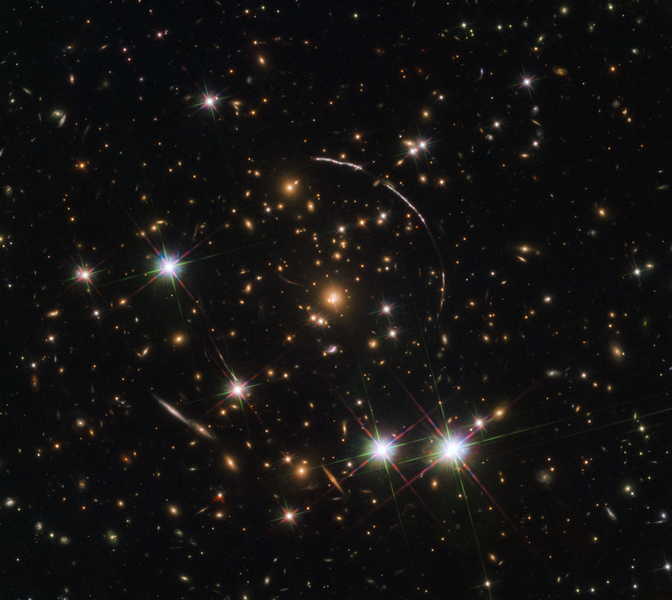File:PSZ1 G311.65-18.48.png

Original file (5,290 × 4,722 pixels, file size: 37.12 MB, MIME type: image/png)
Captions
Captions
Summary[edit]
| DescriptionPSZ1 G311.65-18.48.png |
English: This NASA Hubble Space Telescope photo reveals a cosmic kaleidoscope of a remote galaxy, which has been split into multiple images by an effect called gravitational lensing.
Gravitational lensing means that the foreground galaxy cluster is so massive that its gravity distorts the fabric of space-time, bending and magnifying the light from the more distant galaxy behind it. This “funhouse mirror” effect not only stretches the background galaxy image, but also creates multiple images of the same galaxy. The lensing phenomenon produces at least 12 images of the background galaxy, distributed over four major arcs. Three of these arcs are visible in the top right of the image, while one counter arc is visible in the lower left — partially obscured by a bright foreground star within the Milky Way. The galaxy, nicknamed the Sunburst Arc, is almost 11 billion light-years from Earth and has been lensed into multiple images by a massive foreground cluster of galaxies 4.6 billion light-years away. Hubble uses these cosmic magnifying glasses to study objects that would otherwise be too faint and too small for even its extraordinarily sensitive instruments. The Sunburst Arc is no exception, despite being one of the brightest gravitationally lensed galaxies known. The lens makes images of the Sunburst Arc that are between 10 and 30 times brighter than the background galaxy would normally look. The magnification allows Hubble to view structures as small as 520 light-years across that would be too small to see without the turboboost from the lensing effect. The structures resemble star forming regions in nearby galaxies in the local universe, allowing astronomers to make a detailed study of the remote galaxy and its environment. Hubble’s observations show that the Sunburst Arc is similar to galaxies which existed at a much earlier time in the history of the universe, perhaps only 150 million years after the Big Bang. |
| Date | (released) |
| Source | https://hubblesite.org/image/4583/gallery (image link) |
| Author | NASA, ESA, and E. Rivera-Thorsen (Institute of Theoretical Astrophysics Oslo, Norway) |
This image or video was catalogued by one of the centers of the United States National Aeronautics and Space Administration (NASA) under Photo ID: STScI-2019-58. This tag does not indicate the copyright status of the attached work. A normal copyright tag is still required. See Commons:Licensing. Other languages:
العربية ∙ беларуская (тарашкевіца) ∙ български ∙ català ∙ čeština ∙ dansk ∙ Deutsch ∙ English ∙ español ∙ فارسی ∙ français ∙ galego ∙ magyar ∙ հայերեն ∙ Bahasa Indonesia ∙ italiano ∙ 日本語 ∙ македонски ∙ മലയാളം ∙ Nederlands ∙ polski ∙ português ∙ русский ∙ sicilianu ∙ slovenščina ∙ Türkçe ∙ українська ∙ 简体中文 ∙ 繁體中文 ∙ +/− |
Licensing[edit]
| Public domainPublic domainfalsefalse |
| This file is in the public domain because it was created by NASA and ESA. NASA Hubble material (and ESA Hubble material prior to 2009) is copyright-free and may be freely used as in the public domain without fee, on the condition that only NASA, STScI, and/or ESA is credited as the source of the material. This license does not apply if ESA material created after 2008 or source material from other organizations is in use. The material was created for NASA by Space Telescope Science Institute under Contract NAS5-26555, or for ESA by the Hubble European Space Agency Information Centre. Copyright statement at hubblesite.org or 2008 copyright statement at spacetelescope.org. For material created by the European Space Agency on the spacetelescope.org site since 2009, use the {{ESA-Hubble}} tag. |
File history
Click on a date/time to view the file as it appeared at that time.
| Date/Time | Thumbnail | Dimensions | User | Comment | |
|---|---|---|---|---|---|
| current | 06:34, 30 November 2019 |  | 5,290 × 4,722 (37.12 MB) | Huntster (talk | contribs) | Full resolution from Hubblesite |
| 18:48, 22 November 2019 |  | 2,000 × 1,785 (5.36 MB) | Killarnee (talk | contribs) | User created page with UploadWizard |
You cannot overwrite this file.
File usage on Commons
The following 2 pages use this file:
Metadata
This file contains additional information such as Exif metadata which may have been added by the digital camera, scanner, or software program used to create or digitize it. If the file has been modified from its original state, some details such as the timestamp may not fully reflect those of the original file. The timestamp is only as accurate as the clock in the camera, and it may be completely wrong.
| Credit/Provider | NASA, ESA, Rivera-Thorsen (University of Oslo) |
|---|---|
| Source | STScI |
| Headline | The Sunburst Arc |
| Short title |
|
| Author | Space Telescope Science Institute Office of Public Outreach |
| Image title |
|
| Usage terms | |
| Date and time of data generation | 7 November 2019 |
| PNG file comment |
|
| Date metadata was last modified | 06:57, 31 October 2019 |
| Unique ID of original document | xmp.did:90a73181-044d-4eee-9aa1-1dc0f36a1a67 |
| Contact information | outreach@stsci.edu
3700 San Martin Drive Baltimore, MD, 21218 USA |
| Keywords | PSZ1 G311.65-18.48 |
| Horizontal resolution | 28.34 dpc |
| Vertical resolution | 28.34 dpc |
| File change date and time | 05:55, 31 October 2019 |
